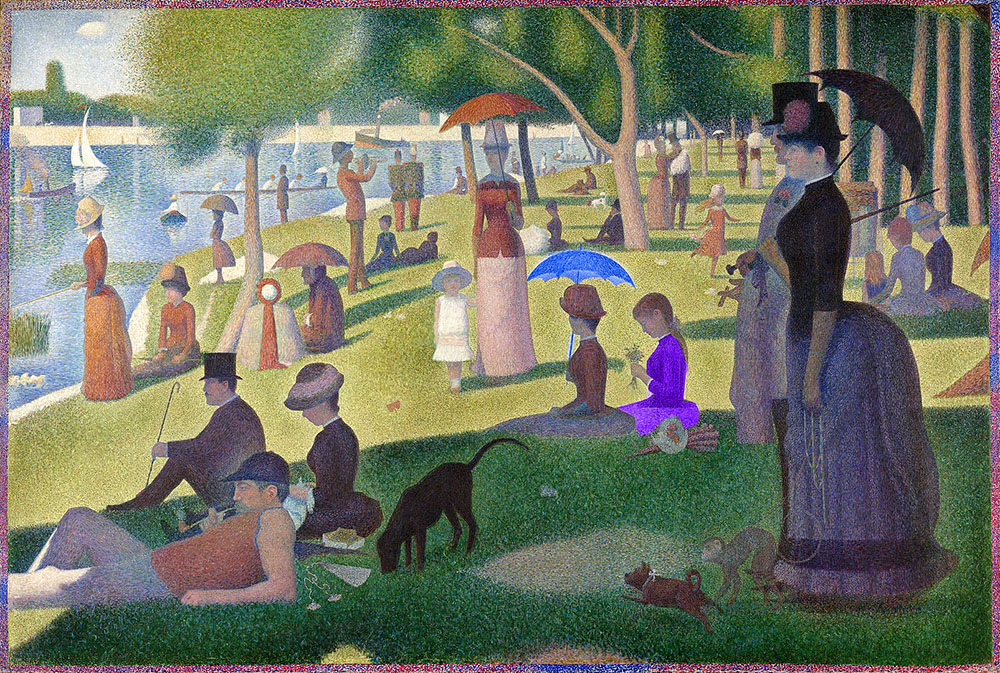
What is Happening in Sunday on La Grande Jatte
On a serene Sunday afternoon in the late 19th century, the island of La Grande Jatte, located on the Seine River near Paris, became a picturesque retreat for city dwellers. This lush, verdant space was a popular leisure destination for Parisians looking to escape the hustle and bustle of urban life. Families, couples, and individuals would gather along the riverbanks to relax, converse, and enjoy the warm sunlight reflecting off the water.
In Georges Seurat’s masterpiece A Sunday Afternoon on the Island of La Grande Jatte, this tranquil scene is immortalized. The painting presents a cross-section of Parisian society, with elegantly dressed figures, children playing, a reclining man smoking his pipe, and a woman holding a parasol. The stiff postures of the figures, along with the vibrant yet structured brushwork, suggest a sense of stillness, almost as if time has momentarily stopped in this idyllic setting.
What Does A Sunday Afternoon on the Island of La Grande Jatte Represent?
Seurat’s painting is a quintessential example of Pointillism, a technique he pioneered that uses tiny dots of pure color to form an image. But beyond its innovative technique, the artwork carries a deep symbolic significance.
The painting encapsulates the changing social fabric of Paris in the late 19th century. At this time, industrialization was transforming the city, and the working class was beginning to mix more freely with the bourgeoisie in public spaces. Seurat captures this moment of social transformation, depicting people from different walks of life engaging in leisure activities side by side.
There is also an element of irony in the painting. While it depicts a moment of rest and relaxation, the figures appear somewhat detached and impersonal. Their rigid postures and lack of interaction may suggest Seurat’s commentary on the structured and somewhat mechanical nature of social life in modern Paris. Some art critics have even interpreted the work as a critique of societal conventions, noting that while the people are together, they remain emotionally distant.
How Much is A Sunday Afternoon on the Island of La Grande Jatte Worth?
Since A Sunday Afternoon on the Island of La Grande Jatte is housed in the Art Institute of Chicago and has never been sold in the modern era, it is difficult to assign an exact monetary value to it. However, based on its historical significance and influence on the art world, experts estimate that if it were ever to go up for sale, it could be worth anywhere between $650 million to $1 billion. This estimate is drawn from the soaring valuations of similarly iconic works by Impressionist and Post-Impressionist painters, as well as the unparalleled significance of the painting in art history.
What is the Message of A Sunday on La Grande Jatte?
Seurat’s painting conveys multiple messages, depending on the lens through which it is viewed:
- The Leisure of the Bourgeoisie – It portrays the newfound ability of the middle class to enjoy leisurely outings, reflecting the evolving culture of relaxation and recreation.
- The Impact of Industrialization – The stiff, almost statue-like figures might be a subtle critique of how modern life had led to a loss of spontaneity in human interactions.
- Harmony through Color and Form – Seurat was obsessed with color theory, and his work is a demonstration of how different hues and scientific precision could create harmony within an artwork.
- A Timeless Snapshot – The painting’s meticulous detail allows viewers to observe Parisian life as it was in the 1880s, almost like a moment frozen in time.
How Long Did it Take to Paint A Sunday on La Grande Jatte?
Seurat worked on the painting meticulously over two years, from 1884 to 1886. During this time, he created over 60 preliminary sketches and studies, experimenting with different compositions, lighting, and color contrasts. He even visited La Grande Jatte multiple times to capture the essence of the location firsthand. His commitment to perfecting the scientific application of color was a significant reason why the painting took so long to complete.
The painting was first exhibited in 1886 at the eighth and final Impressionist exhibition. While it was met with mixed reviews at the time, it later became one of the most celebrated and studied paintings in the history of art.
How Many People Are in A Sunday Afternoon on the Island of La Grande Jatte?
There are approximately 48 figures in the painting, along with several animals, including dogs and a monkey on a leash. The figures range from upper-class women holding parasols to working-class men in casual attire, children playing, and a soldier standing at attention. Each character contributes to the overall dynamic of the scene, making it a rich and intricate portrayal of Parisian society.
Where is A Sunday Afternoon on the Island of La Grande Jatte Located?
Today, A Sunday Afternoon on the Island of La Grande Jatte is housed at The Art Institute of Chicago, one of the world’s most prestigious art museums. It is one of the crown jewels of the museum’s collection, drawing millions of visitors each year who come to admire its meticulous technique and striking visual impact.
A Sunday Afternoon on the Island of La Grande Jatte is much more than just a painting, it is a visual symphony that represents the intersection of art, science, and society. Its innovative technique, timeless social commentary, and enduring influence make it one of the greatest masterpieces in Western art. Whether viewed for its aesthetic beauty, historical significance, or underlying messages, Seurat’s work continues to captivate audiences and inspire new generations of artists and art lovers worldwide.




